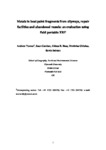Metals in boat paint fragments from slipways, repair facilities and abandoned vessels: An evaluation using field portable XRF
| dc.contributor.author | Comber, SDW | |
| dc.date.accessioned | 2015-11-10T17:00:59Z | |
| dc.date.accessioned | 2015-11-12T08:26:14Z | |
| dc.date.available | 2015-11-10T17:00:59Z | |
| dc.date.available | 2015-11-12T08:26:14Z | |
| dc.date.issued | 2015-01-01 | |
| dc.identifier.uri | http://hdl.handle.net/10026.1/3802 | |
| dc.description.abstract |
Paint flaking off abandoned vessels or generated during boat repair is hazardous to human health and wildlife. In this study, a means of screening paint fragments using a field portable-X-ray fluorescence (FP-XRF) spectrometer is described. The technique is capable of delivering rapid, surficial measurements of Ba, Cu, Pb and Zn down to concentrations less than 150 μg g−1, and Sn and Cr to concentrations of a few hundred μg g−1. Application of the technique to fragments collected from slipways, yards, hardstandings, abandoned boats and ships undergoing maintenance throughout the EU reveal highly variable concentrations of metals among samples from the same environment or from the same region of a given boat; in many cases, variability is also evident in different areas or on different surfaces of the same fragment. Of particular concern are elevated concentrations of substances that have been restricted or banned (e.g. Sn, an indicator of organotin, and up to concentrations of 40,000 μg g−1, and Pb up to concentrations of 200,000 μg g−1). Although FP-XRF can rapidly screen samples whose composition and origin are unknown and can assist in instantaneous decision making, a full risk assessment will rely on additional analyses of the precise species (including organo-forms) of the metals present. | |
| dc.format.extent | 372-378 | |
| dc.language.iso | en | |
| dc.relation.replaces | http://hdl.handle.net/10026.1/3794 | |
| dc.relation.replaces | 10026.1/3794 | |
| dc.title | Metals in boat paint fragments from slipways, repair facilities and abandoned vessels: An evaluation using field portable XRF | |
| dc.type | journal-article | |
| dc.type | Article | |
| plymouth.edition | 131 | |
| plymouth.journal | Talanta | |
| dc.identifier.doi | 10.1016/j.talanta.2014.08.012 | |
| plymouth.organisational-group | /Plymouth | |
| plymouth.organisational-group | /Plymouth/Faculty of Science and Engineering | |
| plymouth.organisational-group | /Plymouth/REF 2021 Researchers by UoA | |
| plymouth.organisational-group | /Plymouth/REF 2021 Researchers by UoA/UoA06 Agriculture, Veterinary and Food Science | |
| plymouth.organisational-group | /Plymouth/Research Groups | |
| plymouth.organisational-group | /Plymouth/Research Groups/BEACh | |
| plymouth.organisational-group | /Plymouth/Research Groups/Marine Institute | |
| plymouth.organisational-group | /Plymouth/Users by role | |
| plymouth.organisational-group | /Plymouth/Users by role/Academics | |
| dcterms.dateAccepted | 2015-01-01 | |
| dc.rights.embargoperiod | Not known | |
| rioxxterms.versionofrecord | 10.1016/j.talanta.2014.08.012 | |
| rioxxterms.licenseref.uri | http://www.rioxx.net/licenses/all-rights-reserved | |
| rioxxterms.type | Journal Article/Review |


